We test the Specialized Epic World Cup: a full mountain bike to forget about hardtails
There has been a great expectation since it was seen for the first time in competition with part of its system hidden. There have been many rumors about this new Specialized Epic World Cup 2024, but after its presentation we have had the privilege of having a unit to test for several days before its launch and here you can find our impressions.
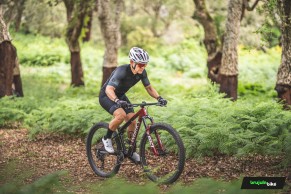
Specialized Epic World Cup: a real luxury for the competition
The new Specialized Epic World Cup is a revolutionary bike in many ways. But it does so not by introducing never-before-seen technological innovations, but by bringing back and refining familiar concepts.
The first thing most riders have asked themselves is whether the rear suspension has Brain. The answer is no. But a quite similar effect has been sought, by another route, i.e. a suspension with a high initial firmness, but with an absorbent and capable performance, once activated.
RECOMENDADO

The best apps for cycling and mountain biking

Black Friday 2025 cycling bargains: save on Garmin, POC, Maxxis and more

Black Friday Garmin 2025: the ultimate guide to choosing your GPS at the best price
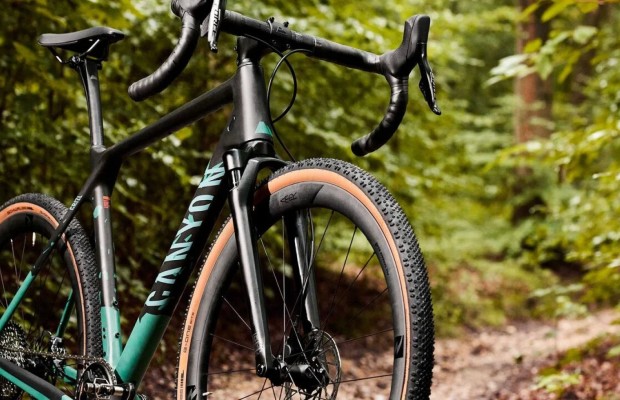
Do you need suspension on your gravel bike?
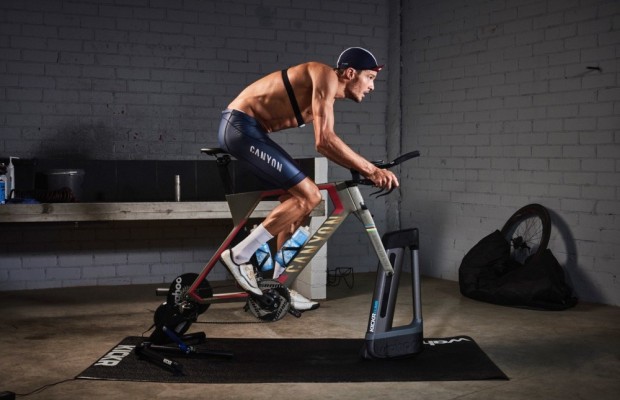
A real workout saver of only 56 min on the turbo trainer

Which profile wheels to choose according to the area where you live: mountain, flat or coast
And how did they do it? By means of a specific rear shock with a positive and a negative air chamber that can be adjusted independently.
The rear suspension is equipped with a 75mm travel, but with the particularity of being all travel in "positive", that is, the Specialized Epic World Cup works without sag in the rear suspension, or with a minimum sag.
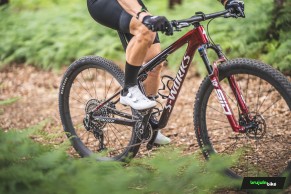
The shock manufactured by Rock Shox and designed in conjunction with Specialized is called Rock Shox SID WCID (World Cup Integrated Design). It is a specific shock for this bike with some specific features. To begin with, its dimensions are somewhat peculiar, since for a 40mm stroke the shock measures 214mm in total length. It has, as we have said, independent positive and negative camber.
Setting up the Rock Shox SID WCID (World Cup Integrated Design) shock absorber
The differences in behavior that we can obtain in this shock absorber are mainly based on the adjustment that we make of the negative chamber.
To obtain a more sensitive suspension we have to load the chamber more, and this is done by emptying the positive chamber through the valve, compressing the shock to the end and then press a bleed button that has the negative chamber, through which air will enter the chamber. After this operation, we inflate the positive chamber to the recommended pressure according to tables provided by Specialized.
For an intermediate sensitivity setting, the operation is the same, but we will operate the bleed button compressing the shock absorber up to half. And if we press the bleed with the damper extended, we will empty the negative chamber obtaining the firmest behavior of the suspension.

There are three theoretical adjustment positions, and this is indicated by markings on the shock rod to make the adjustments, but you can actually bleed the negative chamber at any point in the shock stroke, so the initial firmness adjustment is infinitesimal.
If we adjust the suspension in the firmest mode, we will have the rear end working without sag. In the intermediate position there will be about 2-2.5mm of sag in the shock stroke (about 5% sag). And in the sensitive setting about 4mm (10% sag).
This sensitivity adjustment, which is achieved by modifying the negative cam, mainly affects the start of the movement, i.e. we modify an "activation threshold" that this system has, but once activated the suspension works in much the same way.
Apart from the adjustment of the air chambers, we have a dial to regulate the rebound and another one for compression.
The compression dial has 4 points. Specialized's initial recommendation is to leave it open. But for those who want the most hardtail-like behavior they can opt for the firm setting of the chambers and close the compression for the most radical setting.
In the operation of the rear suspension has been sought, apart from the initial firmness so as not to contaminate the pedaling at all, a great absorption and use of the 75mm of travel available. Thus, the progressivity curve is very flat, compared to that of other suspensions, reaching progressivity at the end of the travel. Thus, once the suspension is activated, it provides great shock absorption.
Testing the Specialized S-Works Epic World Cup
The test unit we have enjoyed is the top of the range version, with a truly spectacular set-up that includes Sram's recently introduced star groupset, the XX SL Eagle Transmission, with its striking wireless shifting that dispenses with the use of a derailleur hanger and is anchored directly to the frame and thru axle.
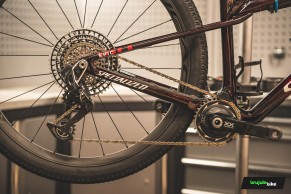
Shifting is controlled by the new POD AXS control, which is fully configurable in terms of ergonomics.
The cassette is also the lightest version, with the three aluminum top sprockets and a new 10-52 step-up.
The cranks are also the XX SL version, with the integrated Quarq power meter and a 34-tooth chainring.
The brakes are also an important novelty since it mounts the new Sram Level Ultimate, with its redesigned lever and the new orientation of the hoses that fits perfectly with the Epic WC's cable routing design.
But the Epic World Cup not only has a new groupset, but also new components, as Specialized recently introduced the new Roval Control SL range.
In this new range we have a spectacular integrated stem and handlebar assembly, including a removable GPS mount and a new ultra-light, recoilless carbon seatpost with infinitesimal adjustment.
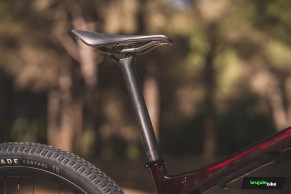
The wheels are also Roval Control SL and mount DT Swiss 180 hub internals, DT Aerolite flat spokes and 29mm internal width carbon rims for an exceptionally lightweight, high performance package.
2.35" tyres in Fast Trak S-Works version for the front wheel and Renegade Control for the rear wheel are chosen.

The set-up is completed, as it could not be otherwise, with a saddle in its S-Works version, in this case the famous Power model.
First impressions in action
We have to admit that there were expectations on our part to know the secrets of this new bike, and the reality totally met these expectations. We found the bike to be very beautiful live. Its shapes are very neat and the integration that has been achieved is very clean.

Looking at the system in detail we find a small linkage that is completely hidden inside the top tube and is responsible for guiding the movement of the shock absorber and reducing forces.
All this integration exercise does not make maintenance difficult at all, since, according to what we were told, the shock absorber can be removed in 1 minute.
Other details we liked are the use of a threaded bottom bracket, which also facilitates maintenance and avoids possible creaking, and the cable routing through the headset, but without the need for a specific stem or handlebar.
There is also continued reliance on the postmount anchor for the rear caliper.
In terms of decoration, this S-Works version is a real eye-catcher when viewed up close. The front of the frame shares paint with the SID fork, with a colorful pattern that, up close and especially in the sun, is spectacular.
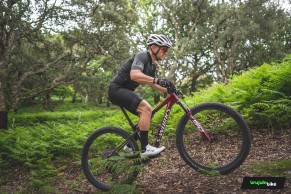
The rear brake line routing is very discreet as it enters through the headset, and the front end is very clean. Also, the new integrated Roval Control SL handlebars look great on this bike.
When we picked it up from the ground we smiled at its lightness and, when we put it on our scales, our sensations were confirmed. 9,530 grams equipped with the two bottle cages and the Garmin mount.
We proceeded to check the sensations of the different rear suspension settings at standstill. For this it is necessary to resort to the tables provided by Specialized to see the recommended pressure, since the adjustment by sag measurement is not valid on this bike.

A curious detail is that in the firmer modes, the pressure to be put on the positive chamber is somewhat lower. This is because the negative chamber also has less pressure and no opposing forces are exerted on each other.
In all adjustment modes we found the setting to be very firm, making us doubt the promised absorption.
So we set off immediately.
At first we opted for the intermediate setting. When we got on the bike we didn't notice any sag at all, that 5% sag in this setting mode is almost imperceptible when riding.
We took the first few pedal strokes feeling like we were riding a hardtail, until we reached an area with small bumps and, as if by magic, the suspension activated. And it's not that it activates slightly, but that it becomes fully operational. We stop to check the telltale and see that we have taken advantage of much of the travel, making it clear that once in operation the system is quite linear and absorbent.
Another detail that many users will wonder is if you still notice that first impact of the Brain, which many people define as a first "clonk". Well, there is no trace, we do not notice at all that first impact and movement of the suspension. That effect of the Brain that has its detractors (although in the latest version is very little noticeable) in the Epic World Cup has gone down in history.
We continue with our tests and we enter a climb on a well-surfaced trail. Here we make amazing accelerations thanks to the tremendous stiffness of the Epic WC that makes it transmit all our strength as if it were a hardtail, and that, coupled with the extreme lightness of this bike gives us a feeling that reminds us of a road bike.
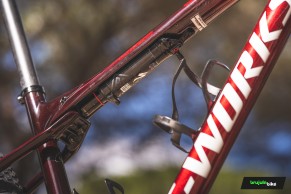
We repeat the ride now with firmer settings and the sensations are even more racing. Now pedaling standing with exaggerated gesture we do not get the suspension to oscillate and, the amazing thing is that it continues to activate with the obstacles without us noticing an initial blow or need for them to be very large impacts, that if, with this firmer setting we do not have an absorption of small curls or slight irregularities as with other more sensitive suspensions.
Also in somewhat more broken climbs we notice that the suspension is activated when needed, but we do not have that sensitivity of other suspensions that draw the terrain constantly. Even so, traction is very good, but does not reach the level of other more active suspensions. This fact improves to some extent with the most sensitive setting, loading the negative chamber of the shock absorber.
Epic World Cup does not forget Down Country
The time has come to test the downhill capabilities of the new Specialized Epic WC. Already looking at its geometry it is clear that this aspect has not been neglected at all. With a generous fork throw of 66.5° and a fairly low center of gravity, the poise it shows when cornering at high speed on the trail is remarkable.
And when it's time to get into rougher trails we also have that dose of control that gives us a modern geometry and suspensions that, when it's time to work, do it in a very surprising way.
Another point in favor of handling in twisty areas is its tremendous lightness, which means that we can place the bike where we want with a slight gesture.

In these steeper areas we do miss a dropper post that allows us to move more freely. Of course the Epic WC frame can be mounted, either wirelessly or by cable drive.
The headset allows the entry of a second cable that can be the one from the seatpost or the one from a hypothetical mechanical rear derailleur.
Regarding the operation of the new Sram XX SL Eagle Transmission groupset, it must be said that the previous version had little room for improvement, but Sram has found it. One of the details that we liked the most is the possibility of adjusting the POD AXS control and placing it exactly where each rider wants. The ergonomics have improved a lot, and this was perhaps the only drawback we found with the previous group.
We also tested the improvement announced by Sram of the shifting under tension, and the truth is that we have "mistreated" the shifting quite a bit in this sense without getting a single failure.
Another detail to highlight is the new cassette staggering. In the previous version we always preferred the 10-50 version, since the 10-52 had a very pronounced last jump. Now the 10-52 has a much more logical and functional step-up.
And the new XX SL cranks come mounted, in this case, with the Quarq power meter, which for the type of user this bike is supposed to be for is an almost essential detail.
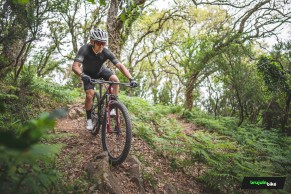
The brakes have also shown a very good performance, showing a more than remarkable power, especially considering the 160mm front disc. In addition, the feel of the new Sram Level Ultimate brakes is quite crisp and at the same time, very easy to control.
The Roval Control SL wheels are one of the best on the market and this combination of rim with 29mm inner and big-ball tyres but with tread pattern seems excellent to us. And of the new Roval Control SL components we find their quality and finish very good and the handlebar, apart from the great aesthetic appeal, seems to us very successful ergonomically and has shown signs of great stiffness when we have demanded it. It must be said that as standard it measures 76cm, but buying it separately it measures 78cm, although it has the markings to cut if you prefer.
Final conclusions
After a few days of very intense testing, we can say that the new Specialized Epic World Cup has left us with an excellent taste in our mouths. This model still has the identity of dispensing with lockout knobs and leaving the work to the suspensions. We also believe that once the optimal setting has been reached according to the rider's preferences, it is not something that will be changed frequently.
It is increasingly difficult to choose a favorite bike, as the Epic standard still has great arguments, as does the Epic EVO, and that's without leaving Specialized.
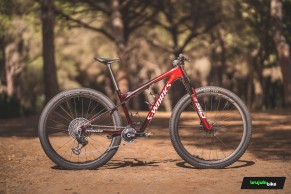
What is clear is that the hardtail loses out in the comparison with the new World Cup, despite a small weight difference. In fact, Specialized is so convinced of this that the high-end HT will disappear to make room for the new World Cup.
What is clear is that it is great news that there is diversity and new concepts. Not all bikes have to evolve and take exactly the same path as there are many types of riders with different priorities and styles, and the fact that the range is expanding is always positive.
Specialized S-Works Epic World Cup: specifications, weight and price
- Frame: S-Works Fact 12m Carbon, WCID suspension design
- Fork: Rock Shox SID SL Ultimate Brain
- Saddle: Specialized Body Geometry S-Works Power
- Handlebar: Roval Control SL integrated cockpit, 76mm
- Brakes: Sram Level Ultimate
- Rear Derailleur: Sram XX SL Eagle Transmission
- Shifter: Sram POD AXS
- Cassette: Sram CS-1299, 10-52
- Chain: Sram XX SL Eagle
- Bottom bracket: Sram XX SL, Quarq power meter, 34T
- Rims: Roval Control SL, 29mm, 24h
- Hubs: Roval Control SL, DT Swiss 180 internals
- Spokes: DT Swiss Aerolite straight pull
- Front Tyre: Specialized S-Works Fast Trak T5/T7, 29x2,35”
- Rear Tyre: Specialized Renegade Control T5, 29x2,35”
- Seatpost: Roval Control SL
- Weight: 9,530g
- Price: 12,500€
Here you can find the rest of the set-ups and prices of the new Epic WC 2024.